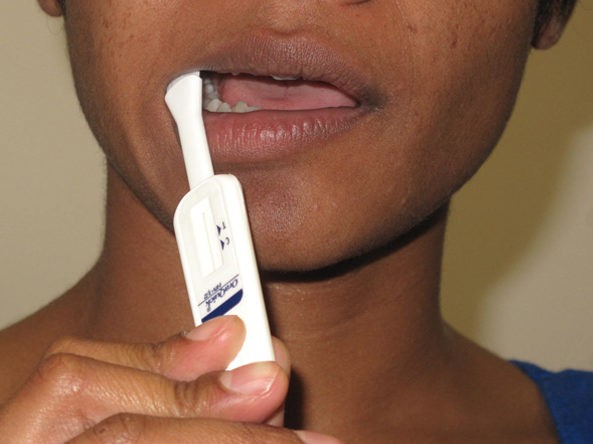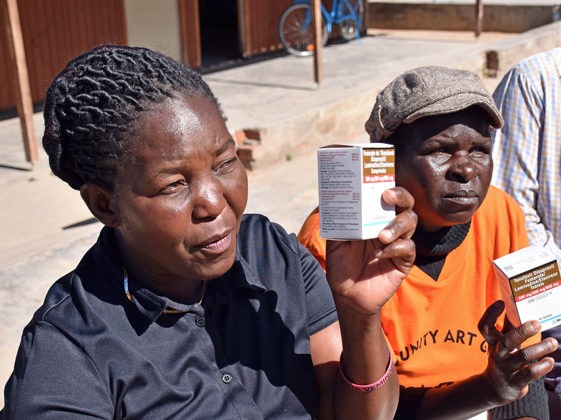Article and Study Summary
Antifungal Combinations for Treatment of Cryptococcal Meningitis in Africa.
Published in:
N Engl J Med. 2018; 378(11):1004-1017.
http://www.nejm.org/doi/full/10.1056/NEJMoa1710922
Authors:
Molloy SF, Kanyama C, Heyderman RS, et al. for the ACTA Trial Study Team.
Summary:
The Advancing Cryptococcal Meningitis Treatment for Africa (ACTA) trial was an open-label, multi-center, randomized, non-inferiority trial that evaluated the efficacy and safety of two alternate treatment strategies for induction treatment of HIV-related cryptococcal meningitis in resource-limited settings. Adults with laboratory-confirmed cryptococcal meningitis were randomized to receive either a two-week oral regimen (fluconazole plus flucytosine), a regimen with one week of amphotericin B, or the standard two-week regimen with amphotericin B. Flucytosine and fluconazole were also evaluated as partner drugs with the amphotericin B regimens. The study found that mortality was similar among the three treatment strategies after two weeks, and that after 10 weeks the one-week amphotericin B with flucytosine regimen had significantly lower mortality than the other combinations evaluated. Toxic side effects were more common in those receiving amphotericin B. Based on these findings, the World Health Organization (WHO) guidelines for the treatment of HIV-related cryptococcal meningitis now recommend one-week amphotericin B plus flucytosine as the preferred induction treatment regimen, and oral fluconazole plus flucytosine as an alternative if amphotericin B is not available or cannot be administered safely.
Download full synopsis in English here or read below.
Full synopsis is also available in Portuguese and French.
Discussion Questions:
- How could the results presented in this article inform cryptococcal meningitis treatment strategies in the populations that you work with?
- What programmatic challenges do you foresee with implementing the new WHOrecommendations based on this study? Do you have any best practices to share?
Please share your thoughts and experiences with us in the comments section below.
Full Synopsis:
Study Summary
The Advancing Cryptococcal Meningitis Treatment for Africa (ACTA) trial was an open-label, multi-center, randomized, non-inferiority trial that compared the efficacy of a two-week oral regimen (fluconazole plus flucytosine) or a one-week regimen with amphotericin B, to the standard two-week regimen with amphotericin B, for induction treatment of cryptococcal meningitis in HIV-positive adults. Flucytosine and fluconazole were also evaluated as partner drugs with amphotericin B.
Study Setting
- Nine hospitals in four African countries (Malawi, Zambia, Tanzania and Cameroon).
Methods
- HIV-positive adults (≥18 years old) with a first episode of cryptococcal meningitis who tested positive on India ink staining, cryptococcal antigen assay, or both in cerebrospinal fluid (CSF) were included.
- Participants were excluded if they had received more than one dose of amphotericin B or more than one treatment dose (1,200 milligrams) or more than seven low doses (200 milligrams) of fluconazole in the two weeks before screening, were pregnant or lactating, were taking contraindicated concomitant drugs, or had any previous adverse reactions to the trial drugs.
- Late-exclusion criteria after randomization were an alanine aminotransferase (ALT) >5 times the upper limit of normal, a polymorphonuclear leukocyte count <500 per cubic millimeter, a platelet count <50,000 per cubic millimeter or a creatinine level >220 micromols per liter on the day after randomization despite intravenous rehydration.
- Participants were randomized to one of three treatment strategies: 1) an oral regimen of fluconazole (1,200 milligrams daily) plus flucytosine (100 milligrams per kilogram daily) for two weeks; 2) a one-week amphotericin B regimen (1 milligram per kilogram intravenously daily) plus either fluconazole (1,200 milligrams daily) or flucytosine (100 milligrams per kilogram daily) for seven days, followed by fluconazole (1,200 milligrams daily) on days eight to 14; or 3) a two-week amphotericin B regimen (1 milligram per kilogram intravenously daily) plus either fluconazole (1,200 milligrams daily) or flucytosine (100 milligrams per kilogram daily) for 14 days.
- Participants who were assigned to an amphotericin B treatment strategy were further randomized to receive one of the two partner drugs, resulting in a 2:1:1:1:1 ratio of participants assigned to receive one of the five combinations.
- Participants who received amphotericin B were given one liter of normal saline intravenously daily, in addition to usual fluid requirements, along with preemptive potassium and magnesium supplementation. Laboratory blood tests were performed regularly during the first two weeks of treatment. Participants with high CSF pressure underwent daily therapeutic lumbar punctures until the pressure was controlled.
- Lumbar punctures were also performed at baseline and on days seven and 14 for quantitative fungal cultures.
- After two weeks, all groups were given fluconazole 800 milligrams daily until ART was started at four weeks, then 400 milligrams daily until 10 weeks, and 200 milligrams daily thereafter.
- The primary end point for comparison of the three treatment strategies was all-cause mortality at two weeks. Secondary end points included four-week and 10-week all-cause mortality, the rate of decrease in the log10 CSF fungal count over 14 days, and grade 3 and 4 adverse events.
- The primary end point for the comparison between partner drugs for the amphotericin B regimens was all-cause mortality at 10 weeks. The secondary end points were all-cause mortality at two weeks and four weeks, rate of clearance of infection, and adverse events.
- Analyses were conducted on an intention-to-treat basis and the non-inferiority margin was pre-specified as 10 percentage points.
Study Population and Follow-up
- From January 2013 to November 2016, a total of 721 participants underwent randomization, of which 678 were included in the intention-to-treat analysis: 225 in the oral regimen group, 224 in the one-week amphotericin B group (111 with fluconazole and 113 with flucytosine) and 229 in the two-week amphotericin B group (114 with fluconazole and 115 with flucytosine).
- The majority of participants were male (range 52.9% to 61.2% across treatment groups). Median age ranged from 36.0 to 38.5 years, and median CD4 cell count ranged from 25 to 26.5 cells per cubic millimeter, with no differences by treatment group.
- Overall 59% of participants were taking, or had previously taken, ART.
Primary Outcomes
- All-cause mortality at two weeks was similar in the oral regimen, one-week amphotericin B, and two-week amphotericin B groups (18.2%, 21.9%, and 21.4%, respectively) and the experimental regimens met the pre-specified non-inferiority criterion.
- As a partner drug with amphotericin B, flucytosine was superior to fluconazole, with 10-week all-cause mortality rates of 31.1% and 45.0%, respectively (hazard ratio [HR] 0.62, 95% CI 0.45–0.84).
Secondary Outcomes
- In the oral regimen, one-week amphotericin B, and two-week amphotericin B regimen groups, mortality at 10 weeks was 35.1%, 36.2% and 39.7%, respectively.
- The one-week amphotericin B–flucytosine group had the lowest 10-week mortality (24.2%, 95% CI 16.2–32.1), which was significantly lower than all the other treatment combinations.
- The rate of clearance of infection in CSF was similar in the one-week and two-week amphotericin B groups and more rapid in the amphotericin B groups than in the oral regimen group. Flucytosine as the partner drug with amphotericin B was associated with more rapid clearance than fluconazole (p<0.001).
- Any grade 3 or 4 adverse event occurred in 57.3% of participants in the oral regimen group, 57.1% in the one-week amphotericin B group, and 67.5% in the two-week amphotericin B group.
- Laboratory-defined adverse events were less frequent in the oral regimen group than in the one-week or two-week amphotericin B groups.
- Grade 4 anemia (hemoglobin <6.5 grams per deciliter) developed in 0.9% of participants in the oral regimen group, 4.9% in the one-week amphotericin B group, and 8.8% in the two-week amphotericin B group.
- A grade 3 or 4 increase in the serum creatinine level (defined as >218 micromoles per liter) developed in 4.9% of participants in the oral regimen group, 6.2% in the one-week amphotericin B group, and 8.8% in the two-week amphotericin B group.
- Grade 4 neutropenia (polymorphonuclear leukocyte count <500 per cubic millimeter) was recorded in 3.2% of participants who received two weeks of flucytosine, in 0.9% of those taking one week of flucytosine, and in 1.3% of those taking a flucytosine-free regimen.
Critical Analysis
This study demonstrated that both an oral regimen with higher dose fluconazole plus flucytosine and a one-week amphotericin B-based regimen were non-inferior to a two-week amphotericin B-based regimen for induction treatment of HIV-related cryptococcal meningitis in resource-limited settings. It also found flucytosine to be superior to fluconazole as a partner drug with amphotericin B, and that one week of amphotericin B with flucytosine was associated with the lowest 10-week mortality.
The following points should be considered when interpreting the study findings:
- This was an open-label study, therefore participants and providers were not blind to group allocation. However, many of the measures, including the primary outcome measures of mortality, were objective in nature.
- Participants received preemptive management and monitoring of amphotericin B-related toxicities, but even with these measures, participants receiving amphotericin B-based regimens had more laboratory-defined side effects than those receiving the oral regimen. This suggests that the relative mortality benefit of the oral regimen may be greater in settings where amphotericin B cannot be administered safely and monitored closely.
- Two-week mortality was chosen as the primary end point because death within this period was more likely to be related to cryptococcal meningitis. However, mortality continued to rise after the first two weeks. It is unclear how much of the mortality after week 2 was attributable to complications from cryptococcal meningitis or to other comorbidities from advanced HIV disease.
- Participants in this study received a high level of care, including frequent laboratory monitoring, use of nasogastric tubes to administer oral medication for those unable to swallow, therapeutic lumbar punctures for high CSF pressure, and blood transfusions as needed, which may limit the generalizability of these findings to lower-resource settings in which overall mortality will likely be higher.
- Despite receiving treatment and a high level of care, over a third of participants in all three groups had died by week 10, highlighting the very high mortality rate associated with cryptococcal meningitis and the need for timely diagnosis and treatment.
Implications
The ACTA trial evaluated the efficacy of two alternative induction treatment strategies for HIV-related cryptococcal meningitis in resource-limited settings, and found that a combination oral regimen and a one-week amphotericin B-based regimen were as effective as the standard two-week amphotericin B-based regimen. Of all combinations evaluated, one week of amphotericin B with flucytosine was the most effective, and is now recommended by the World Health Organization (WHO) as the preferred induction regimen.(1) The recent WHO guidelines also recommend the oral induction regimen (flucytosine plus fluconazole) as an alternative option if amphotericin B cannot be safely administered, or two weeks of amphotericin B with fluconazole if flucytosine is not available. While this is an important step to improving access to treatment and management of cryptococcal meningitis in resource-limited settings, there is still very limited access to flucytosine in many countries. Going forward, governments and stakeholders should work toward improving access to flucytosine and updating their guidelines for the management of cryptococcal meningitis accordingly.
References
- World Health Organization. Guidelines for the diagnosis, prevention, and management of cryptococcal disease in HIV-infected adults, adolescents and children. Geneva, 2018. Available at: http://www.who.int/hiv/pub/guidelines/cryptococcal-disease/en/









